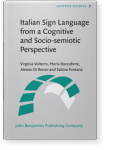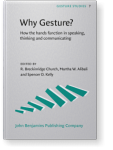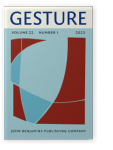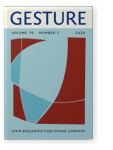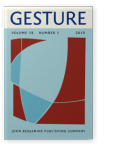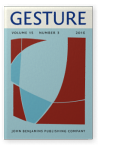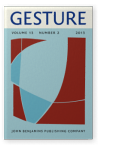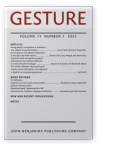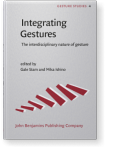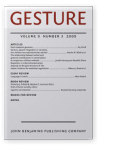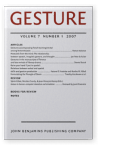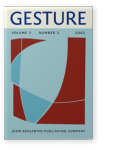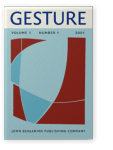Martha W. Alibali
List of John Benjamins publications for which Martha W. Alibali plays a role.
Book series
Title
Why Gesture?: How the hands function in speaking, thinking and communicating
Edited by Ruth Breckinridge Church, Martha W. Alibali and Spencer D. Kelly
[Gesture Studies, 7] 2017. vii, 433 pp.
Subjects Cognition and language | Communication Studies | Discourse studies | Gesture Studies | Pragmatics
2023 Weakest link or strongest link? The effects of different types of linking gestures on learning Gesture 22:1, pp. 1–38 | Article
Teachers often use gestures to connect representations of mathematical ideas. This research examined (1) whether such linking gestures help students understand connections among representations and (2) whether sets of gestures that include repeated handshapes and motions – termed gestural… read more
2020 Learning from an avatar video instructor: The role of gesture mimicry Gesture 19:1, pp. 128–155 | Article
Teachers often produce gestures, and, in some cases, students mimic their teachers’ gestures and adopt them into their own repertoires. However, little research has explored the role of gesture mimicry in technology-based learning contexts. In this research, we examined variations in the rate… read more
2019 Teachers’ attitudes about gesture for learning and instruction Gesture 18:1, pp. 31–56 | Article
We developed and tested a survey instrument to measure teachers’ attitudes about gesture in learning and instruction (TAGLI). Teachers (N = 192) generally believed that instructional gestures are beneficial for learning, and not distracting for students. Teachers had positive expectations, both… read more
2017 Chapter 2. Representational gestures help speakers package information for speaking Why Gesture?: How the hands function in speaking, thinking and communicating, Church, Ruth Breckinridge, Martha W. Alibali and Spencer D. Kelly (eds.), pp. 15–37 | Chapter
Abstract
The Information Packaging Hypothesis (IPH; Kita, 2000) holds that gesture helps speakers package information into units appropriate for verbalization. When information packaging is more difficult, speakers produce more gestures. Further, manipulations of gesture can affect… read more
2017 Chapter 1. Understanding gesture: Description, mechanism and function Why Gesture?: How the hands function in speaking, thinking and communicating, Church, Ruth Breckinridge, Martha W. Alibali and Spencer D. Kelly (eds.), pp. 3–10 | Chapter
Abstract
Gestures offer additional information that is not captured in speech. This essential finding is a bouncing off point for the chapters in this book, which attempt to explain what purpose gesture serves when we speak, think and communicate. Aristotle’s framework is used to… read more
2017 Chapter 13. Making and breaking common ground: How teachers use gesture to foster learning in the classroom Why Gesture?: How the hands function in speaking, thinking and communicating, Church, Ruth Breckinridge, Martha W. Alibali and Spencer D. Kelly (eds.), pp. 285–316 | Chapter
Abstract
Teachers regularly use gesture as part of multimodal instruction to both break and make common ground. Teachers break common ground when they introduce new ideas and new mathematical practices. Teachers make common ground by connecting new ideas to students’ prior… read more
2016 The temporal relationship between speech and manual communicative gesture in children with specific language impairment Gesture 15:3, pp. 321–339 | Article
This study examined the relationship between word frequency and timing of communicative gestures in children with specific language impairment (SLI) and typically-developing (TD) children. Nine children with SLI and twelve age-matched TD children produced a narrative after watching an animated… read more
2013 Students learn more when their teacher has learned to gesture effectively Gesture 13:2, pp. 210–233 | Article
Teachers’ gestures are an integral part of their instructional communication. In this study, we provided a teacher with a tutorial about ways to use gesture in connecting ideas in mathematics instruction, and we asked the teacher to teach sample lessons about slope and intercept before and after… read more
2011 Cognitive skills and gesture–speech redundancy: Formulation difficulty or communicative strategy? Gesture 11:1, pp. 40–60 | Article
Speakers sometimes convey information in their gestures that they do not convey in the accompanying speech. The present study examined whether individual differences in the production of non-redundant gesture–speech combinations are related to individual differences in speakers’ spatial and verbal… read more
2011 Chapter 5. If you don’t already know, I’m certainly not going to show you!: Motivation to communicate affects gesture production Integrating Gestures: The interdisciplinary nature of gesture, Stam, Gale and Mika Ishino (eds.), pp. 61–74 | Chapter
The present study aimed to determine if variations in a speaker’s motivation to communicate influence the frequency or size of the gestures the speaker produces. We observed the gestures produced by speakers as they gave route directions to a listener who they believed would use the information… read more
2011 Chapter 19. How gesture use enables intersubjectivity in the classroom Integrating Gestures: The interdisciplinary nature of gesture, Stam, Gale and Mika Ishino (eds.), pp. 257–266 | Chapter
In communication it is essential for speaker and listener to establish intersubjectivity, or “common ground.” This is especially true in instructional settings where learning depends on successful communication. One way teachers enable intersubjectivity is through the use of gestures. We consider… read more
2010 Gesture highlights perceptually present information for speakers Gesture 10:1, pp. 3–28 | Article
Why do speakers produce gestures? This study tests the hypothesis that gesture facilitates the conceptual planning of speaking, and in particular, gesture promotes thinking about perceptually present information. This view implies that, when gesture is prohibited, people should be less likely to… read more
2009 Gesture–speech integration in narrative: Are children less redundant than adults? Gesture 9:3, pp. 290–311 | Article
Speakers sometimes express information in gestures that they do not express in speech. In this research, we developed a system that could be used to assess the redundancy of gesture and speech in a narrative task. We then applied this system to examine whether children and adults produce… read more
2007 Raise your hand if you’re spatial: Relations between verbal and spatial skills and gesture production Gesture 7:1, pp. 73–95 | Article
Individuals differ greatly in how often they gesture when they speak. This study investigated relations between speakers’ verbal and spatial skills and their gesture rates. Two types of verbal skill were measured: semantic fluency, which is thought to index efficiency with lexical access, and… read more
2002 Children’s gestures are meant to be seen Gesture 1:2, pp. 113–127 | Article
This study investigated whether children alter their gestures when their listeners cannot see those gestures. Sixteen kindergarten children viewed four short cartoon episodes. After each episode, the child retold the story to an adult listener. For two episodes, the child and listener sat… read more
